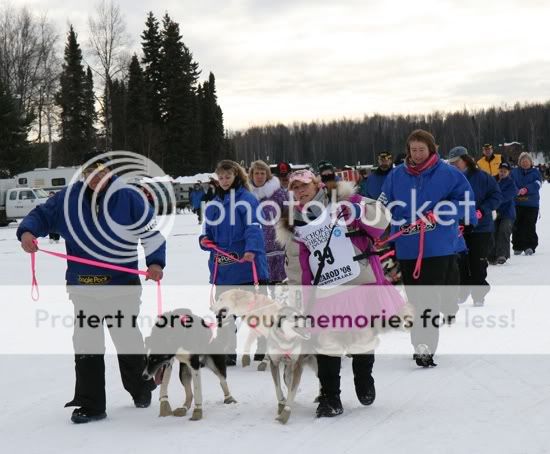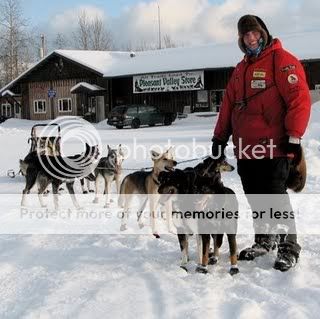
Weeks ago I started a series on studying the Iditarod, but I got a little distracted from finishing it up. The good news is that I got my living room and dining room painted, attended several swim meets, took a day trip to Chicago, hosted a neighborhood gathering... you get the point! If you missed the first two segments, read these posts first:
As much as we enjoyed reading about the Iditarod and preparing our map, the best part of the Iditarod project is following the race. Since my kids are accustomed to swim meets and track meets, where races are finished in minutes and seconds, it was mind-boggling for them to think of a race taking 9-15 days. We really learned the meanings of endurance and perseverance by watching these amazing dogs and their leaders.
After you have completed your Iditarod trail map, it is time to pick a musher. You are going to chart your musher's progress on your map and record how long it takes for the team to reach each checkpoint.
We had fun looking through the list of mushers and learning a little about their backgrounds. You can find a list of the 2010 mushers here. It was tough choosing a team, but we finally settled on veteran musher DeeDee Jonrowe. We chose her because 1) she's a woman (Anna's request), 2) she has had several top 10 finishes in the Iditarod, 3) she has a website that enabled us to know a little bit more about her and her dogs, 4) she has an amazing story of overcoming breast cancer, 5) she is the best-dressed musher (everyone knows her for her fuchsia parka), and 6) she is an outspoken Christian.
photo by Theresa Daily
DeeDee did not disappoint -- she and her team did a great job, finishing 13th. She completed the race in 10 days, 22 hours, 56 minutes, and 10 seconds and was awarded $17,300. We look forward to following her progress in the 2010 Iditarod.
Another musher we really enjoyed following was Aliy Zirkle, who finished in 17th place. She and her husband, Allen Moore, both had teams in last year's race -- she led the more experienced dogs and he led a team of up-and-comers.
They have the best blog, The SP Kennel Dog Log, that was frequently updated during the race, so we really felt like we got to know the team. In fact, I still follow their blog and love learning about the new puppies and the great video of their training sessions. A recent post showed what 4 tons of dog food looks like! (To my husband -- and you thought we have to buy a lot of dog food!)
My kids adore one of the dogs, Happy, who ran her first Iditarod last year. This sweet dog's story is every bit as engaging as our favorite Iditarod books I wrote about in my first post.
The Iditarod has it's critics, and if you read the comments on my first Iditarod post, you saw that I was asked not to "hype" the Iditarod to the homeschool community. But if you follow the SP Kennel blog for even a short time, I think you will see that these dogs are loved and cared for like family members. I'll also add that the first time I harnessed my own Siberian Husky to go skijoring, I was surprised at how she knew exactly what to do. She came from a family of show dogs, but pulling was in her blood, and I never saw her happier than when I took her on a run. That hardly makes me an expert, but it's my 2 cents. The topic might be interesting for an older student to research.
Now for some final notes on following the race. The standings are updated frequently on the Official Iditarod website, and that is how we followed most of the race. The eIditarod Project assigns optional activities for each checkpoint that add to the fun and learning. But as the race progressed we started wishing we had spent the money to subscribe to Iditarod Insider. The Insider offers subscriptions to video feed (including lots of live footage) and/or a GPS tracker. We did finally break down and get the video subscription, but if I were to do it over I'd get both the video and the GPS tracker. Even though we knew when a racer was getting close to the finish, all it takes is a blink and you miss it because you didn't know how exactly how close the team was to the finish. The video and GPS tracker cost $19.95 each or $33.95 together.
As I worked on this post this morning, Grace saw one of the pictures and immediately started jabbering away about various Iditarod things, and it made it even clearer how much my kids loved our this study. We will continue to be fans of the Iditarod, although a little bit more informally. Instead of the Iditarod, this year our winter project will be learning about Holland for our local homeschool group's "Around the World" celebration. But if you're looking for something to energize your homeschool studies during the long winter months, I highly recommend checking out the eIditarod Project. Registration has not begun for 2010 yet, but last year's registration started December 1st and closed January 9th. I will update this post when new information is available.

Thank you to DeeDee Jonrowe and Aliy Zirkle for granting permission to use these pictures!





So I'm wondering if you've read "The Call of the Wild" with the kids after or with this project? VERY different treatment of dogs but also shows that they are designed for this type of work IMO.
ReplyDeleteWhat a great project!
For the dogs, the Iditarod is a bottomless pit of suffering. Six dogs died in the 2009 Iditarod, including two dogs on Dr. Lou Packer's team who froze to death in the brutally cold winds. What happens to the dogs during the race includes death, paralysis, frostbite (where it hurts the most!), bleeding ulcers, bloody diarrhea, lung damage, pneumonia,
ReplyDeleteruptured discs, viral diseases, broken bones, torn muscles and tendons and sprains. At least 142 dogs have died in the race. No one knows how many dogs die after this tortuous ordeal or during training.
On average, 52 percent of the dogs who start the race do not make it across the finish line. According to a report published in the American Journal of Respiratory and Critical Care Medicine, of those who do finish, 81 percent have lung damage. A report published in the Journal of Veterinary Internal Medicine said that 61 percent of the dogs who complete the Iditarod have ulcers versus zero percent pre-race.
Iditarod dog kennels are puppy mills. Mushers breed large numbers of dogs and routinely kill unwanted ones, including puppies. Many dogs who are permanently disabled in the Iditarod, or who are unwanted for any reason, including those who have outlived their usefulness, are killed with a shot to the head, dragged, drowned or clubbed to death. "Dogs are clubbed with baseball bats and if they don't pull are dragged to death in harnesses......" wrote former Iditarod dog handler Mike Cranford in an article for Alaska's Bush Blade Newspaper.
Dog beatings and whippings are common. During the 2007 Iditarod, eyewitnesses reported that musher Ramy Brooks kicked, punched and beat his dogs with a ski pole and a chain. Jim Welch says in his book Speed Mushing Manual, "Nagging a dog team is cruel and ineffective...A training device such as a whip is not cruel at all but is effective." "It is a common training device in use among dog mushers..."
Jon Saraceno wrote in his March 3, 2000 column in USA Today, "He [Colonel Tom Classen] confirmed dog beatings and far worse. Like starving dogs to maintain their most advantageous racing weight. Skinning them to make mittens.. Or dragging them to their death."
During the race, veterinarians do not give the dogs physical exams at every checkpoint. Mushers speed through many checkpoints, so the dogs get the briefest visual checks, if that. Instead of pulling sick dogs from the race, veterinarians frequently give them massive doses of antibiotics to keep them running.
Most Iditarod dogs are forced to live at the end of a chain when they aren't hauling people around. It has been reported that dogs who don't make the main team are never taken off-chain. Chained dogs have been attacked by wolves, bears and other animals. Old and arthritic dogs suffer terrible pain in the blistering cold.
The Iditarod, with all the evils associated with it, has become a synonym for exploitation. The race imposes torture no dog should be forced to endure.
Margery Glickman
Director
Sled Dog Action Coalition, http://www.helpsleddogs.org
I think this article is right on target. A lot of good points and advice on the subject. I have found that when doing my research, sites like this offer the best unbiased opinions and are very good in helping me make a decision. Another fine source of information on a Bark Collar, Dog Fence and Pet Door is available from this handy guide on Pet Supplies.
ReplyDelete